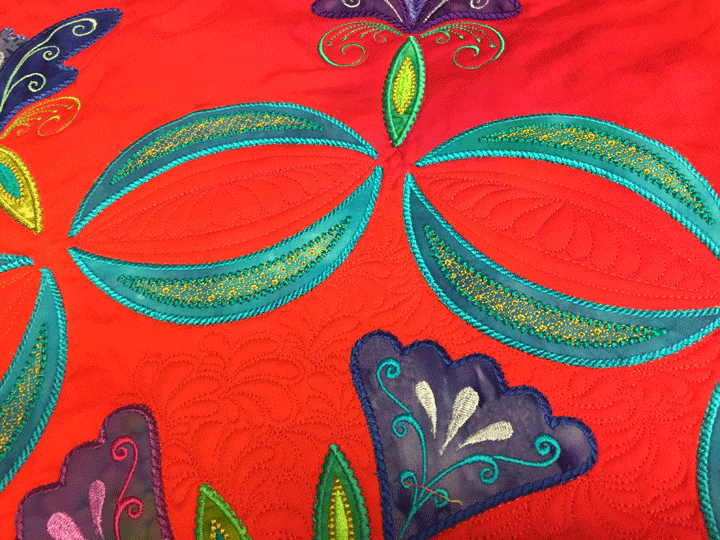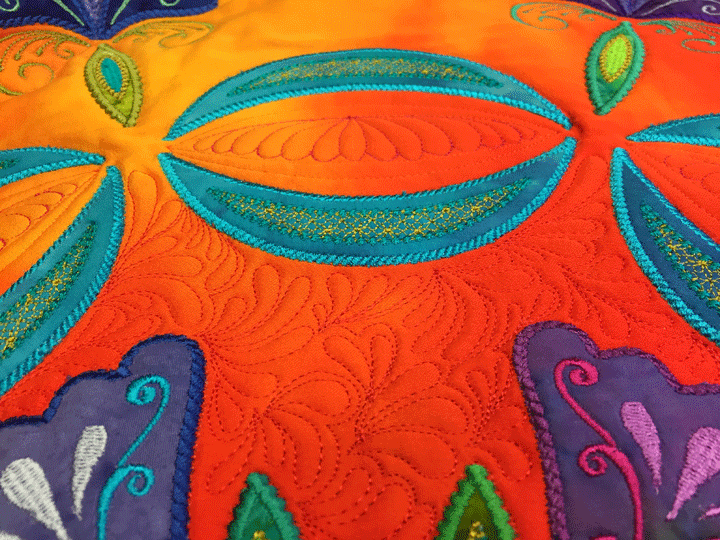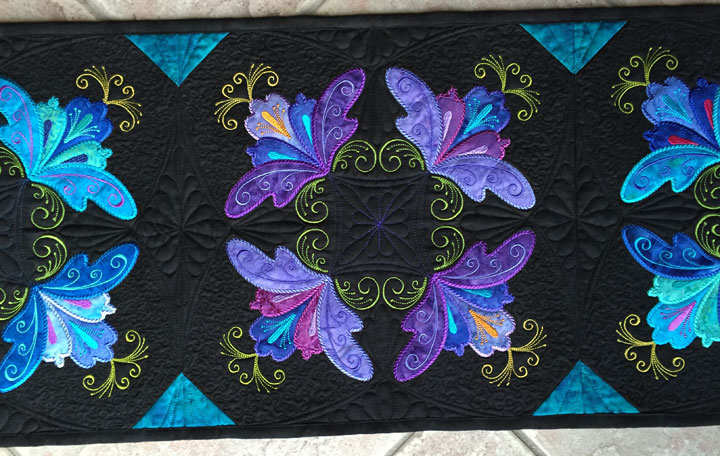November 17th, 2016
 Because almost every quilt I’ve made in the last few years has been a MEA quilt, my challenge in designing ruler work quilted designs always breaks down to creating designs to custom fit the spaces between applique shapes. This is very easy to do if you have a quilt top applique design that is symmetric, as you simply chose landmarks on the applique design to “play off.” This will always ensure a symmetric ruler work design since these same landmarks are used repetitiously and symmetrically in this type of applique designwork. The shot above is an example of a ruler work design that custom fills that oddly shaped space formed by pairs of swirls coming together. There are always multiple ways to fill this space, and if we look at a shot of an earlier wall hanging using this same applique design, you’ll see that this same space was filled differently:
Because almost every quilt I’ve made in the last few years has been a MEA quilt, my challenge in designing ruler work quilted designs always breaks down to creating designs to custom fit the spaces between applique shapes. This is very easy to do if you have a quilt top applique design that is symmetric, as you simply chose landmarks on the applique design to “play off.” This will always ensure a symmetric ruler work design since these same landmarks are used repetitiously and symmetrically in this type of applique designwork. The shot above is an example of a ruler work design that custom fills that oddly shaped space formed by pairs of swirls coming together. There are always multiple ways to fill this space, and if we look at a shot of an earlier wall hanging using this same applique design, you’ll see that this same space was filled differently:
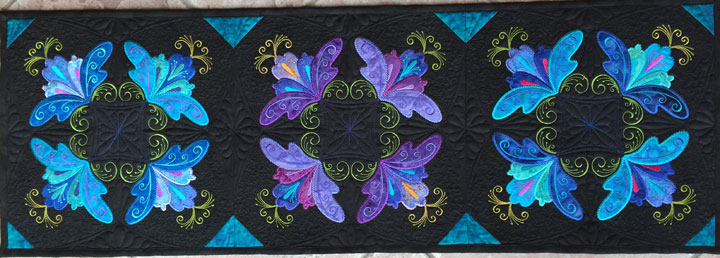 In the black wall hanging, I used the base of each flower as my starting/ending point for arc ruler work, but in the Christmas wall hanging, I’ve used the space between swirls as my starting/ending points for arc ruler work. They each yield a different center space to fill with a featherette, and they each yield different “outer spaces.” The Christmas version left me with enough room to add 4 additional featherettes. Let me show you how easy this is to do from the beginning. This next shot zooms in on the space we need to fill. Notice that there is a tiny blue dot between each pair of swirls. These are temporary marks that denote the starting and ending points for my ruler work:
In the black wall hanging, I used the base of each flower as my starting/ending point for arc ruler work, but in the Christmas wall hanging, I’ve used the space between swirls as my starting/ending points for arc ruler work. They each yield a different center space to fill with a featherette, and they each yield different “outer spaces.” The Christmas version left me with enough room to add 4 additional featherettes. Let me show you how easy this is to do from the beginning. This next shot zooms in on the space we need to fill. Notice that there is a tiny blue dot between each pair of swirls. These are temporary marks that denote the starting and ending points for my ruler work:
 I used an oval ruler to create my first round of swags. Why’d I use an oval ruler instead of an arc ruler? Good question! An oval ruler will give me more plunge, and I needed to add more depth/plunge than an arc ruler would give me. When you use an oval ruler, you need to take care to center it each time you place it or the plunge will be off center:
I used an oval ruler to create my first round of swags. Why’d I use an oval ruler instead of an arc ruler? Good question! An oval ruler will give me more plunge, and I needed to add more depth/plunge than an arc ruler would give me. When you use an oval ruler, you need to take care to center it each time you place it or the plunge will be off center:
 (Can you see that I was trying to line up the center line of the oval with the center of that flower?) Here’s what the center design looked like once the first round was stitched:
(Can you see that I was trying to line up the center line of the oval with the center of that flower?) Here’s what the center design looked like once the first round was stitched:
 Remember that rule #1 in ruler work is you always want at least 1 channel, so I took a very shallow arc ruler and used it to create a tapered channel:
Remember that rule #1 in ruler work is you always want at least 1 channel, so I took a very shallow arc ruler and used it to create a tapered channel:
 Adding a channel always makes the design more interesting. Next, I made some temporary marks to divide up the interior into quadrants that could guide my freehand stitching of 2 featherettes:
Adding a channel always makes the design more interesting. Next, I made some temporary marks to divide up the interior into quadrants that could guide my freehand stitching of 2 featherettes:
 …and once I’d filled the center with 2 featherettes, I went back and filled the blank space below each pair of swirls with another featherette:
…and once I’d filled the center with 2 featherettes, I went back and filled the blank space below each pair of swirls with another featherette:
 When you see a complex-appearing design like this, always try to break it down into component parts and then you’ll see how easy it is to construct symmetric designs like this. Here’s wishing you hours of fun playing with rulers!
When you see a complex-appearing design like this, always try to break it down into component parts and then you’ll see how easy it is to construct symmetric designs like this. Here’s wishing you hours of fun playing with rulers!
Filed under
Free Motion Quilting, Machine Embroidered Applique, ruler work on a HDSM.
November 14th, 2016
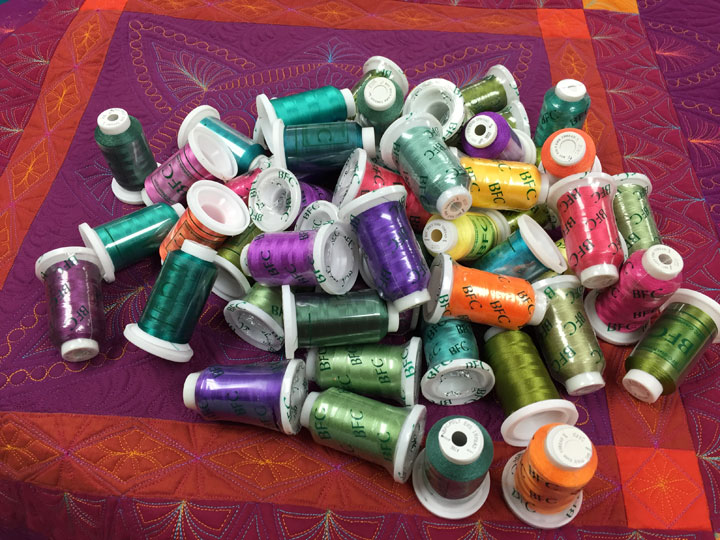 I caved and indulged myself in the thread sale at BFC stash. I don’t need any more thread but these spools were an incredible deal and I’ve been happy with their trilobal polyester thread for both quilting and embroidery. I’ve also been running through thread as I’ve had my hands in all kinds of quilty projects over the last few days. I started making a Christmas-y version of the serpentine floral table runner I designed recently:
I caved and indulged myself in the thread sale at BFC stash. I don’t need any more thread but these spools were an incredible deal and I’ve been happy with their trilobal polyester thread for both quilting and embroidery. I’ve also been running through thread as I’ve had my hands in all kinds of quilty projects over the last few days. I started making a Christmas-y version of the serpentine floral table runner I designed recently:
 I also went back in and added small featherettes between my border motifs on my Kissed by a Butterfly Quilt. I stitched these in a different thread color than the border design, one that is closer to the background fabric color so it’s not as noticeable:
I also went back in and added small featherettes between my border motifs on my Kissed by a Butterfly Quilt. I stitched these in a different thread color than the border design, one that is closer to the background fabric color so it’s not as noticeable:
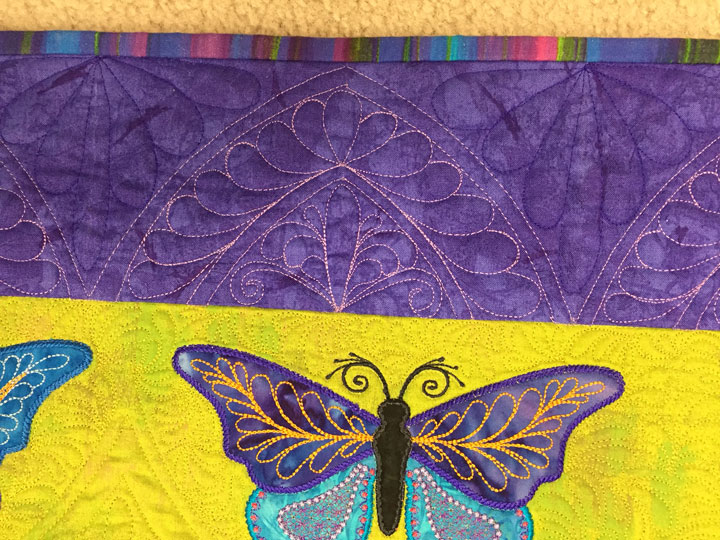 I did this because a judge commented that the un-quilted areas looked “too blank.” Here’s the before shot:
I did this because a judge commented that the un-quilted areas looked “too blank.” Here’s the before shot:
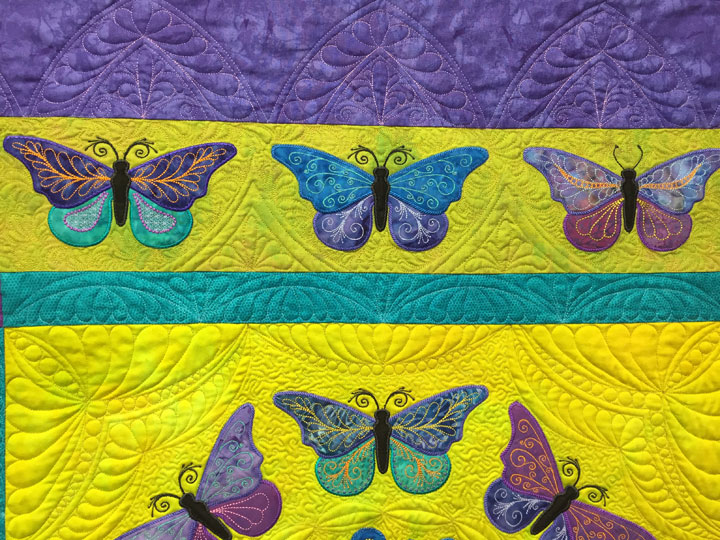 I’d honestly thought about doing this when I first made the quilt, but then decided it didn’t need it. Have to say that I like it better now. Here’s the after shot:
I’d honestly thought about doing this when I first made the quilt, but then decided it didn’t need it. Have to say that I like it better now. Here’s the after shot:
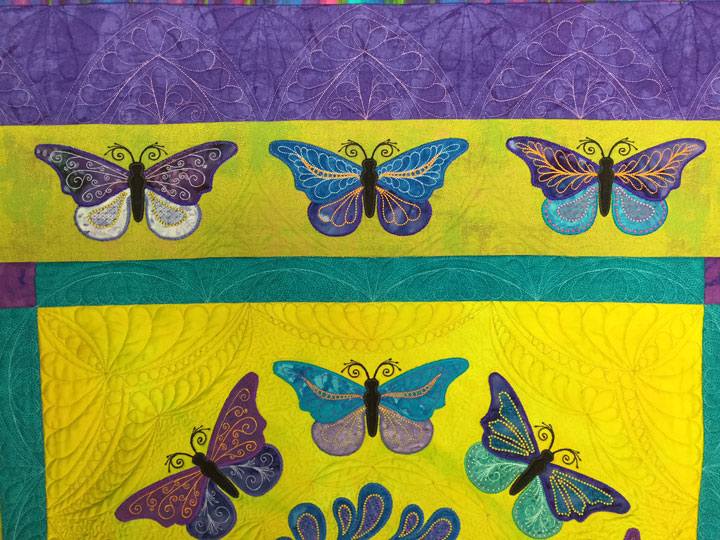 I also started a Christmas version of my recent black quilted tablerunner. Here’s the center green block:
I also started a Christmas version of my recent black quilted tablerunner. Here’s the center green block:
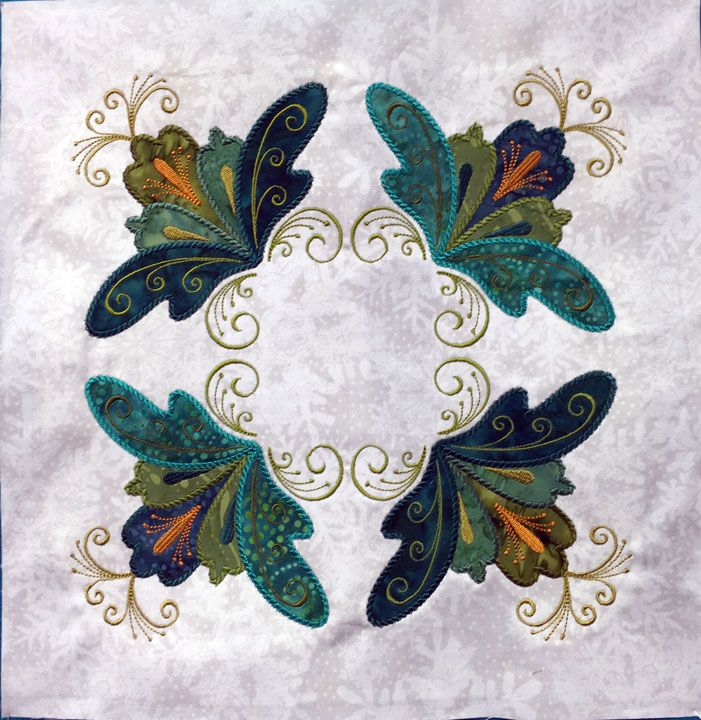 …and here’s what one of the red blocks looks like:
…and here’s what one of the red blocks looks like:
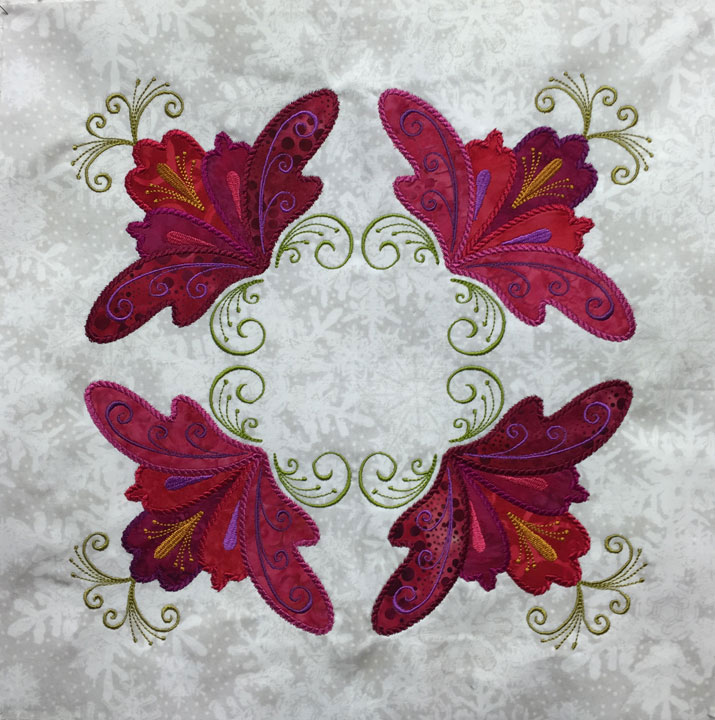 Ern has been busy making all kinds of ruler holders for quilters:
Ern has been busy making all kinds of ruler holders for quilters:
 He makes them in different types of wood and different inlay designs:
He makes them in different types of wood and different inlay designs:
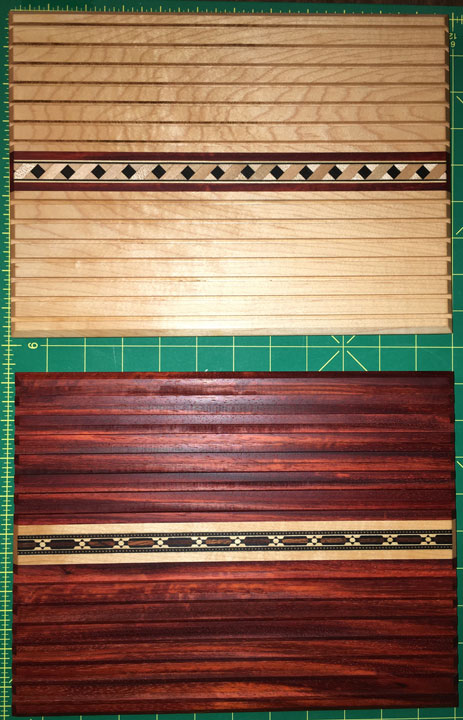 He also makes gorgeous thread racks. I have a different thread rack next to each of my embroidery machines and use them all the time:
He also makes gorgeous thread racks. I have a different thread rack next to each of my embroidery machines and use them all the time:
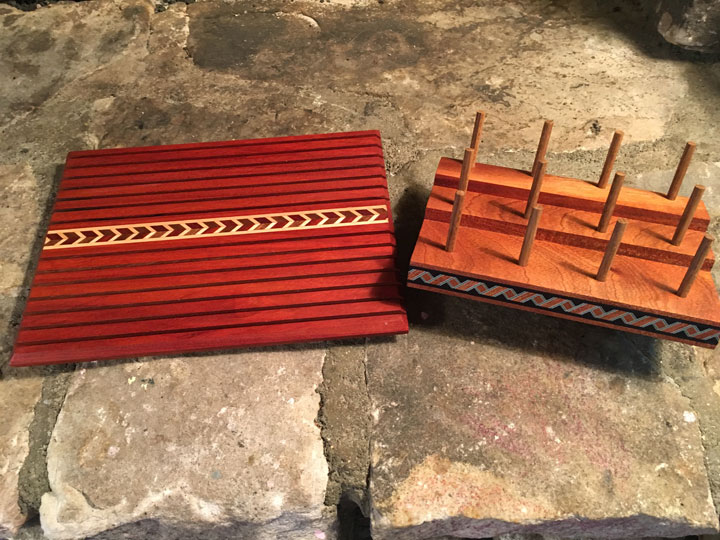 He even makes really beautiful ice cream scoops like these:
He even makes really beautiful ice cream scoops like these:
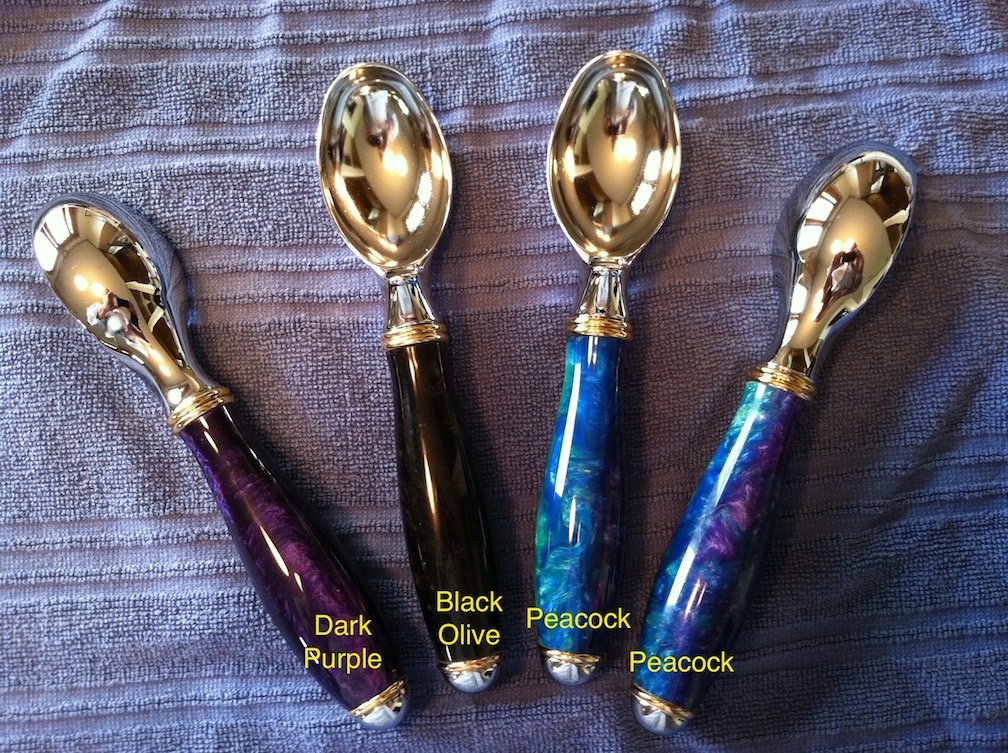 If you’ve been thinking about one of these as a Christmas gift, now is the time to place your order as he makes these to your specifications. You can find them in our online store by clicking here for ruler holders and here for thread racks. He’s also been making lots of seam rippers, stilettos, and keychain screwdriver/stilettos:
If you’ve been thinking about one of these as a Christmas gift, now is the time to place your order as he makes these to your specifications. You can find them in our online store by clicking here for ruler holders and here for thread racks. He’s also been making lots of seam rippers, stilettos, and keychain screwdriver/stilettos:
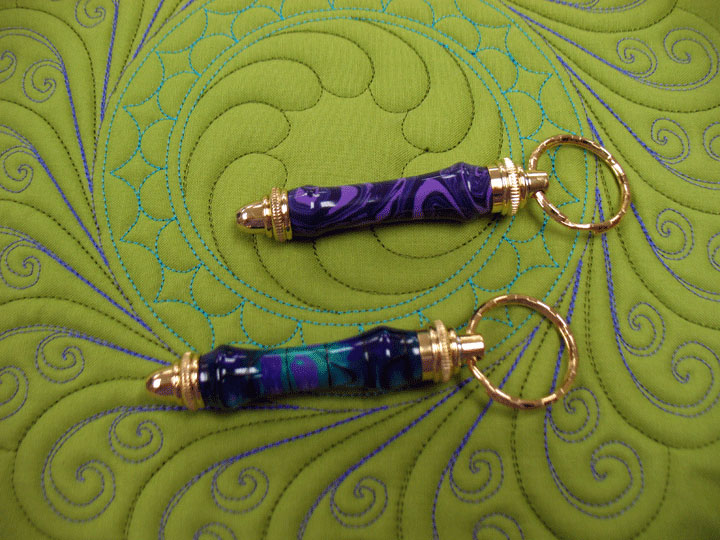 The shot above shows a couple of keychain screwdrive/stilettos in their “resting state.” If you unscrew the end, you see that they hold 3 different screwdriver tips and 1 stiletto tip:
The shot above shows a couple of keychain screwdrive/stilettos in their “resting state.” If you unscrew the end, you see that they hold 3 different screwdriver tips and 1 stiletto tip:
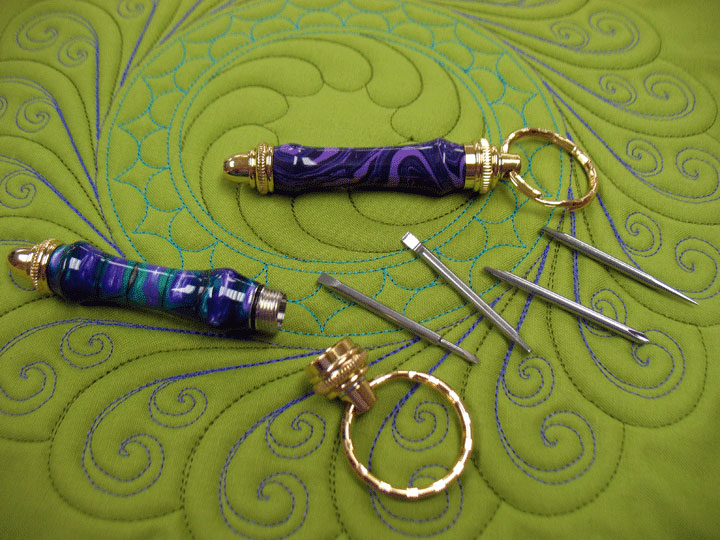 Once you choose a tip, you slip it into the end, and you’re ready to use this beautiful tool! I use my screwdriver tips all the time to put my ruler foot onto my sewing machine:
Once you choose a tip, you slip it into the end, and you’re ready to use this beautiful tool! I use my screwdriver tips all the time to put my ruler foot onto my sewing machine:
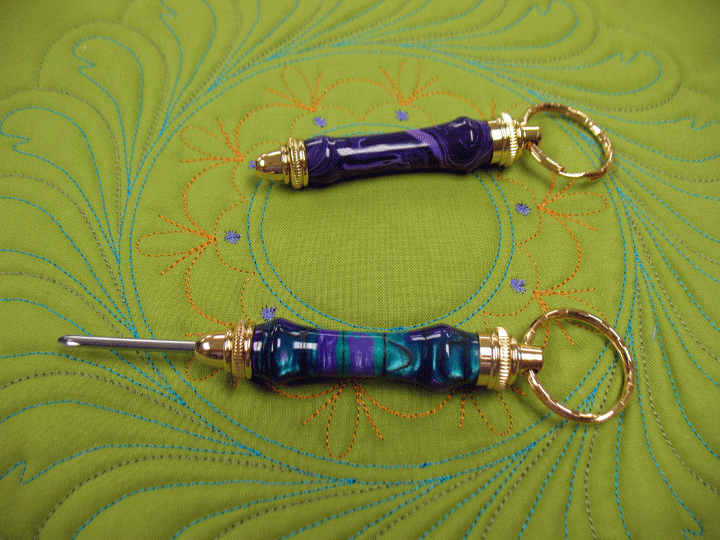 Ern can make these up in all kinds of colors to match your taste. If you want to have them ready for the holiday, now’s the time to order and you can find all of Ernie’s handmade gifts in our online store by clicking here.
Ern can make these up in all kinds of colors to match your taste. If you want to have them ready for the holiday, now’s the time to order and you can find all of Ernie’s handmade gifts in our online store by clicking here.
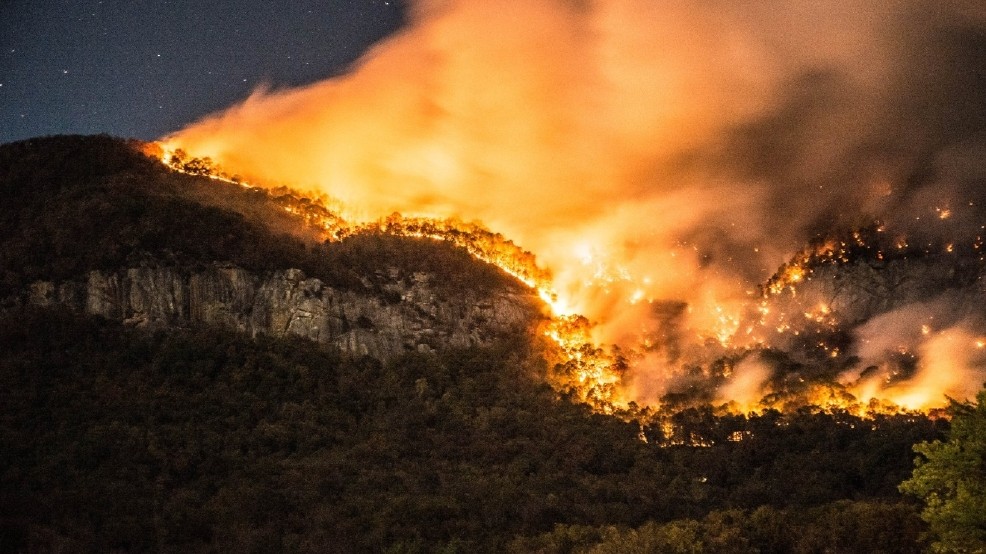 In sad news, our beloved western NC is literally on fire because of the extreme drought. The air here is very hazy and smoke-filled and we haven’t been able to spend anytime outdoors for several days because the air quality is so poor that it’s dangerous. Say a prayer for these wildfires to come under control soon…
In sad news, our beloved western NC is literally on fire because of the extreme drought. The air here is very hazy and smoke-filled and we haven’t been able to spend anytime outdoors for several days because the air quality is so poor that it’s dangerous. Say a prayer for these wildfires to come under control soon…
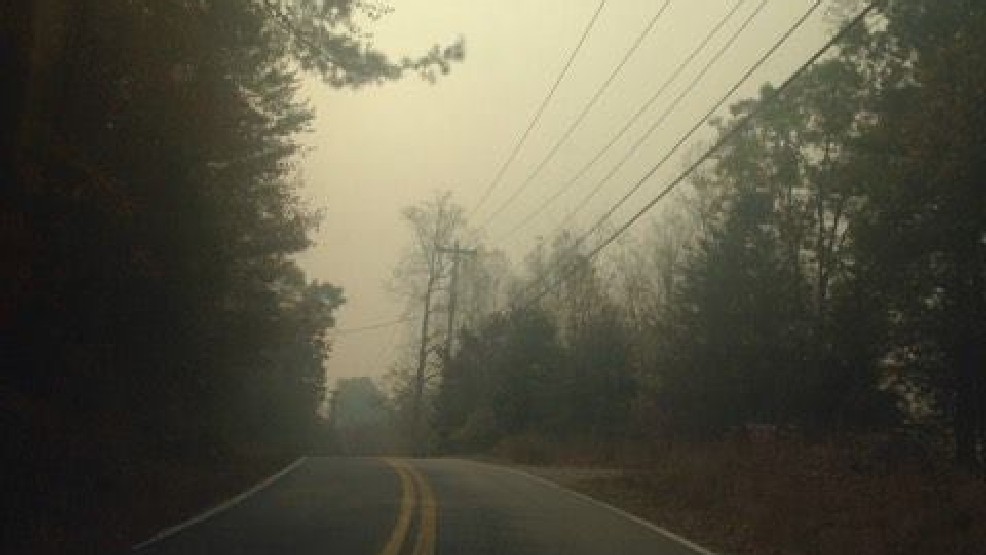
Filed under
Free Motion Quilting, Machine Embroidered Applique, Store Updates.
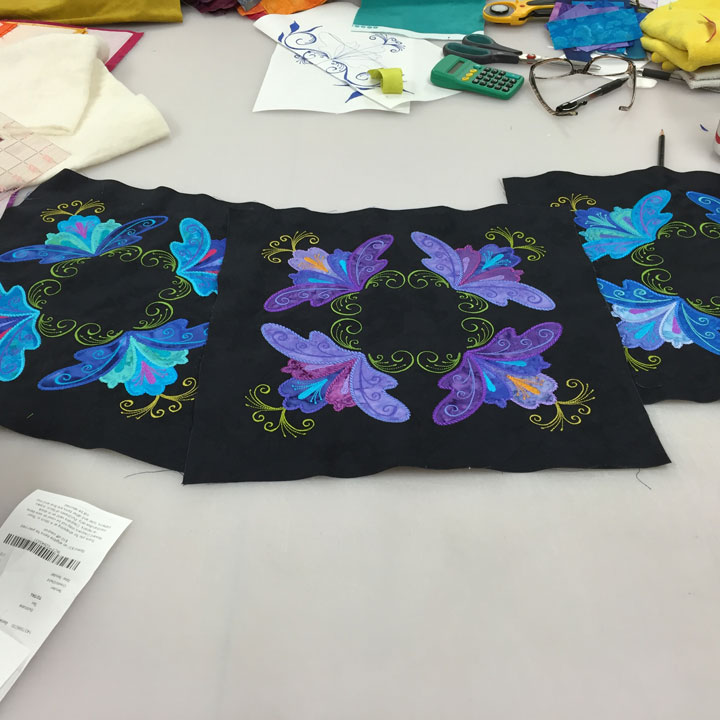 Last Fall, I created several blocks like the ones above for the center of a quilt. I finished them up and here’s what they looked like when I laid them out on the floor:
Last Fall, I created several blocks like the ones above for the center of a quilt. I finished them up and here’s what they looked like when I laid them out on the floor:
 I added a small triangle at each of the corners of each block, and here’s how they look all pieced together:
I added a small triangle at each of the corners of each block, and here’s how they look all pieced together:
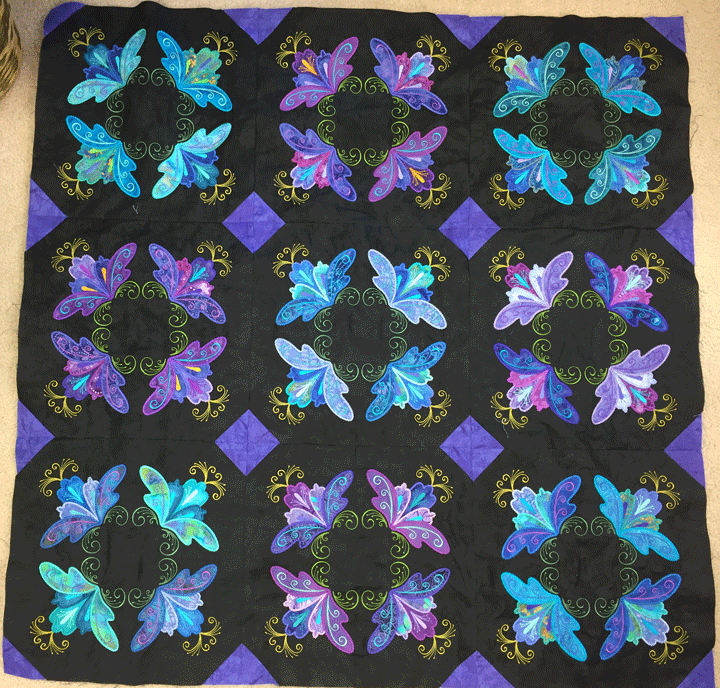 I finally got back to it recently and started working on the first appliqued border. Here you can see one of the borders in process:
I finally got back to it recently and started working on the first appliqued border. Here you can see one of the borders in process:
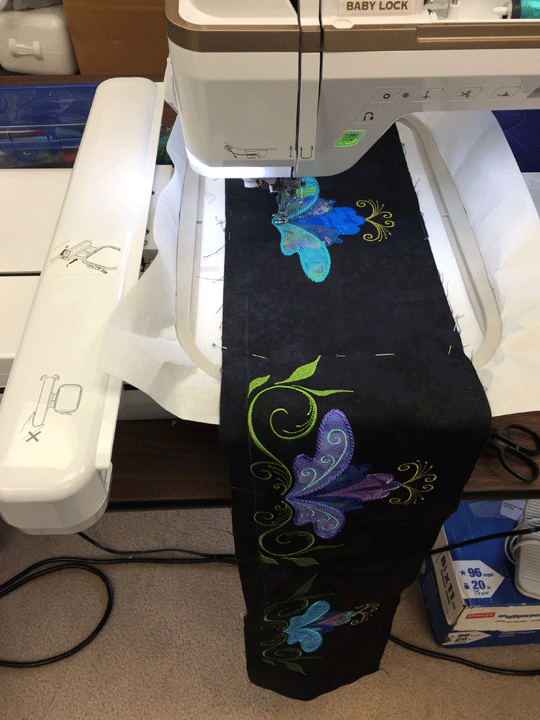 I am lucky and can embroider more than one border at once; here is a shot that shows 2 borders being worked on simultaneously:
I am lucky and can embroider more than one border at once; here is a shot that shows 2 borders being worked on simultaneously:
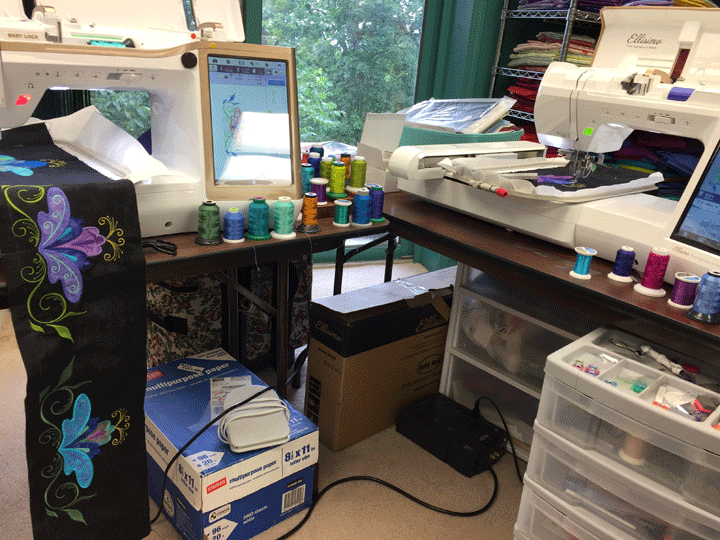 …and here are all 4 borders laid out on the floor:
…and here are all 4 borders laid out on the floor:
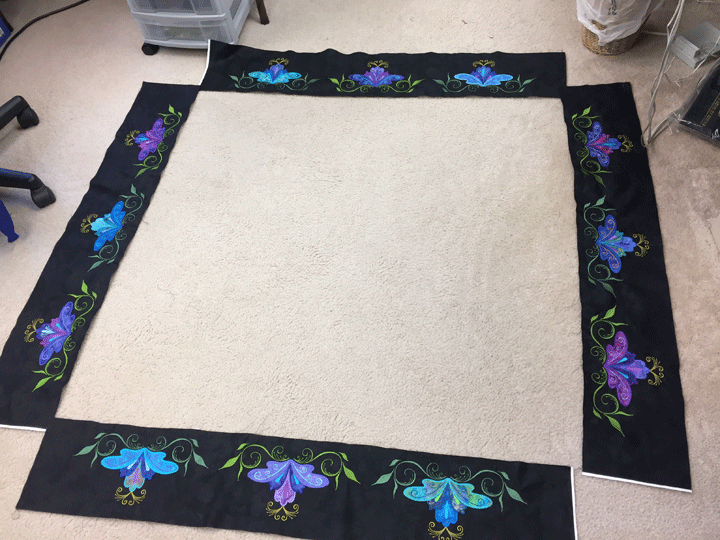 This has been an odd month. I spent the first part of the month traveling and teaching, so there was no time to sew outside of doing class demos. We drove to NC last week and I was really looking forward to a few weeks of intense sewing/quilting. When we opened our garage door, we found that a leak from the kitchen had waterlogged the ceiling in the garage (suspended ceiling of ceiling tiles) and the tiles had all broken into wet pieces and fallen down. The insulation was soaked as well. The floor was covered with smelly water and a “paste-like” mess from degrading ceiling tiles. Lovely! We went upstairs and found that about a quarter of the wood floor in the dining room was soaked, as was about a quarter of the kitchen tiles. The culprit that caused all this was a tiny, pin-hole sized crack in the plastic tubing that carries water to the ice maker in the refrigerator. (We have since learned this is a common problem and can be avoided by replacing that tubing with a small piece of braided steel tubing that costs between $12-$25.) We ended up calling one of those disaster recovery teams and they rigged up this interesting system to dry things out. Here’s a shot that gives you an idea of what things looked like from upstairs:
This has been an odd month. I spent the first part of the month traveling and teaching, so there was no time to sew outside of doing class demos. We drove to NC last week and I was really looking forward to a few weeks of intense sewing/quilting. When we opened our garage door, we found that a leak from the kitchen had waterlogged the ceiling in the garage (suspended ceiling of ceiling tiles) and the tiles had all broken into wet pieces and fallen down. The insulation was soaked as well. The floor was covered with smelly water and a “paste-like” mess from degrading ceiling tiles. Lovely! We went upstairs and found that about a quarter of the wood floor in the dining room was soaked, as was about a quarter of the kitchen tiles. The culprit that caused all this was a tiny, pin-hole sized crack in the plastic tubing that carries water to the ice maker in the refrigerator. (We have since learned this is a common problem and can be avoided by replacing that tubing with a small piece of braided steel tubing that costs between $12-$25.) We ended up calling one of those disaster recovery teams and they rigged up this interesting system to dry things out. Here’s a shot that gives you an idea of what things looked like from upstairs:
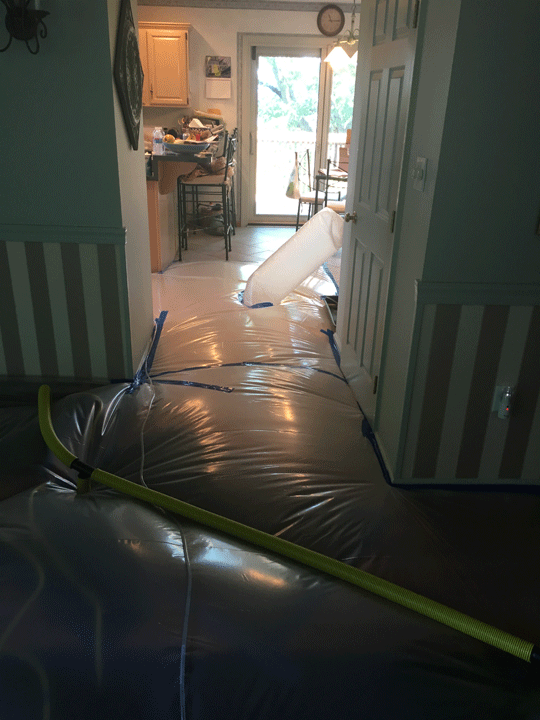 This was a drying/de-humidifcation process that went on for several days. From the garage below, a small “room” was walled off and heated/dehumidified to help dry the wood and tiles that were above. Here are 2 shots of the garage set-up:
This was a drying/de-humidifcation process that went on for several days. From the garage below, a small “room” was walled off and heated/dehumidified to help dry the wood and tiles that were above. Here are 2 shots of the garage set-up:
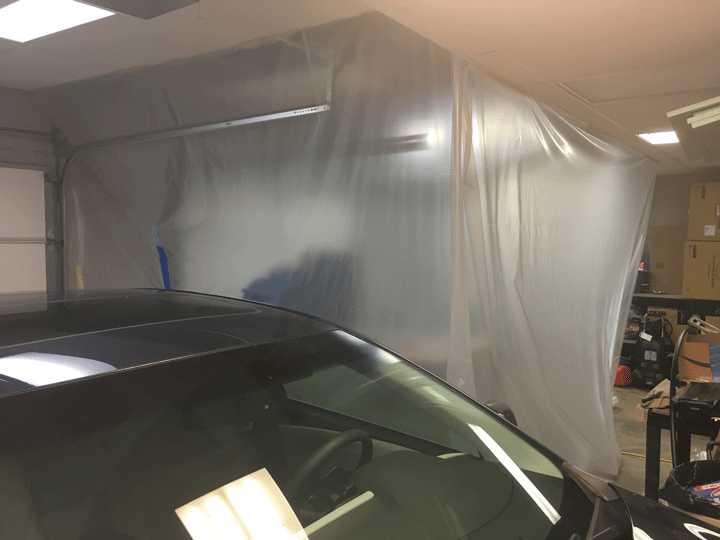 …and here’s a shot of what was in the room:
…and here’s a shot of what was in the room:
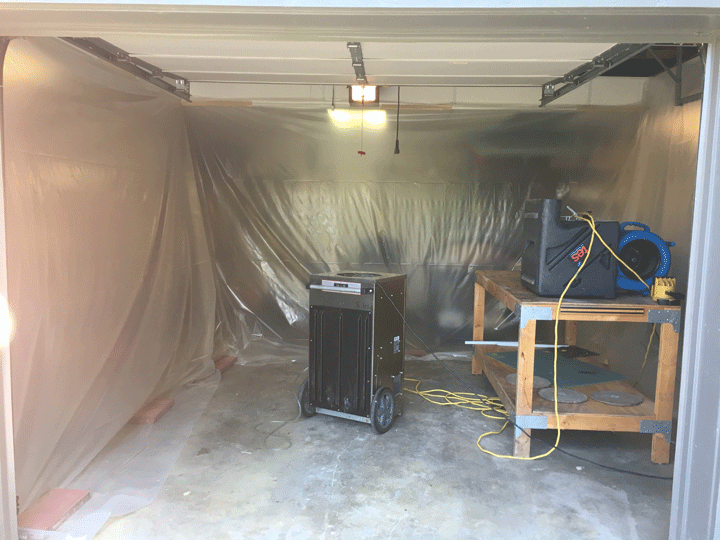 These machines all worked for 24 hours/day and it was like being on a tarmac for many days because of all the noise. The people who helped us were WONDERFUL (1-800-water damage) and we are happy to say that everything really did dry out and we didn’t have to rip up the wood floors or the tiles! It is so nice to be back to a normal routine with silence again and I am looking forward to some productive time in my sewing room!!
These machines all worked for 24 hours/day and it was like being on a tarmac for many days because of all the noise. The people who helped us were WONDERFUL (1-800-water damage) and we are happy to say that everything really did dry out and we didn’t have to rip up the wood floors or the tiles! It is so nice to be back to a normal routine with silence again and I am looking forward to some productive time in my sewing room!!




